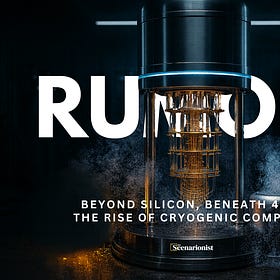Deep Tech Monthly in Review – July 2025
Field Notes from The Scenarionist. A Strategic Recap for Builders and Backers
Dear Builders and Backers,
July didn’t escalate — it converged. Across every layer of the stack — from capital design to compute physics, from orbital insurance to engineered food supply — we saw deep tech shift from novelty to necessity.
The defining theme? Constraint is no longer a temporary friction — it’s the baseline condition. And those who thrive aren’t avoiding it. They’re underwriting it.
Startups are no longer built on projections. They’re built on systems: energy buffers, sovereign guarantees, edge hardware, policy interlocks. The July signal was consistent: markets are not rewarding speed. They’re rewarding mastery of throughput.
We saw AI chips used as collateral for capital deployment, turning model scale into financial leverage. Photonic and cryogenic architectures moved from physics experiments to sovereign-backed industrial bets. In fusion, both inertial and stellarator designs were funded not for their elegance — but for their manufacturability. Biotech platforms are aligning with food and climate use cases, not just FDA milestones. From semiconductors to crops, the new standard is dual-mode readiness: scientifically credible and geopolitically aligned.
The shape of capital is also evolving. While traditional equity rounds remain present, they’re increasingly supplemented — and in some cases, led — by more sophisticated structures: non-dilutive grants tied to execution milestones, debt facilities linked to long-term offtakes, sovereign-backed credit lines paired with commercial tranches. This is not a departure from venture; it’s a sign that deep tech is finally being financed on terms appropriate to its complexity and scale.
Execution is now the moat. Not patents. Not roadmaps. Companies that can compress permitting delays, pre-negotiate offtakes, absorb EPC friction, and hit readiness faster than the grid or factory or buyer expects — those are the ones attracting capital with zero narrative premium.
Importantly, sovereign alignment is becoming the gating item — not the bonus. Companies working on energy independence, localized biomanufacturing, strategic compute, or logistics redundancy are increasingly operating in lanes where the capital is not just abundant — it’s pre-committed, if the structure fits.
In parallel, we’re seeing a strategic shift in how liquidity is approached. The best-positioned companies aren’t waiting for exits. They’re engineering them — by embedding them into the operational logic of their growth: via structured commercial agreements, infrastructure readiness, and integration paths that make them inevitable nodes in someone else’s network. These aren’t exits by chance — they’re liquidity by design.
And all of this is happening against a backdrop of sovereign reindustrialization. July confirmed what many suspected: strategic sectors — from microgravity pharma to autonomous mining — are no longer competing for capital. They are being prioritized by it.
Challenges persist, of course. Industrial timelines are still subject to latency — from site activation to regulatory asymmetry. And emerging segments like quantum-adjacent orchestration or dual-use AI still face gaps between technical feasibility and buyer readiness. The companies pulling ahead are those that treat infrastructure, compliance, and procurement not as blockers — but as preconditions to compounding scale.
Through 17 original assets — spanning capital flows, operator playbooks, policy analysis, and market briefings — we mapped what moved, what mattered, and what it means for anyone serious about building where physics meets finance.
Use this recap not as a retrospective — but as a strategic checkpoint. To see not just what’s happening — but how it compounds.
In this cycle, it’s not the loudest pitch that wins. It’s the most coherent system. One that knows how to turn friction into margin — and infrastructure into strategic permanence.
Stay sharp. Stay sovereign-aligned. Build for constraint.
5 Key Takeaways from our July pieces
From factory-as-IP to AI-capital hybridization, July reframed how Deep Tech survives the scale-up valley.
1. Deep Tech is maturing into a capital stack discipline, not a capex sink.
This July, the clearest signal was that funding a frontier startup is no longer about “how much” but “how structured.” From nuclear microreactors to photonic AI chips, the best founders are using equity to absorb raw tech risk, layering in non-dilutive grants for early proof points, and proactively leveraging debt for buildouts once techno-economics pencil out.
We saw project finance instruments land in fusion, geothermal, and energy storage — but the real unlock came from sequencing. Investors are rewarding teams that treat capital like a storyboard: equity for invention, grants for derisking, and infrastructure debt for execution. This isn’t just about dilution — it’s about operational optionality. Founders who map funding to milestone granularity now walk into Series B with a real right to scale.
2. The factory is no longer back office — it’s front-end product.
Across materials, energy, and agbio, July showed a quiet truth: your first pilot line isn’t a cost. It’s your second product. Modular, measurable, and increasingly underwritable.
Lenders, offtakers, and partners aren’t waiting for scale. They’re pricing signal-rich throughput from FOAK facilities as early as Day 1. The telemetry your factory produces — from uptime to process yield — is now a data room in motion. What used to be called CapEx now reads like infrastructure-grade IP.
3. Dominance starts at the edge, not the center.
From RNA-powered crop tools to microgravity pharma, July highlighted ventures that found power in precision — not scale. The pattern is holding: owning one narrow vertical with unforgiving specs is more investable than chasing a trillion-dollar TAM.
Why? Because niches compress uncertainty. They force technical refinement, shorten sales cycles, and build gravitational pull. The founders who lead with focus aren’t playing small — they’re compounding credibility.
4. Fusion and compute broke the hype ceiling — by grounding in milestones.
This month proved that fusion is no longer a “maybe.” It’s a field being mapped by KPIs like Q > 1, triple-product density, and keV thresholds. And AI infrastructure is doing the same — with photonic chip players, silicon-leasing models, and rack-backed debt creating financial benchmarks as solid as any SaaS metric.
The message? Scientific legitimacy is finally translating into investability. Founders are learning to package real progress — not theoretical upside — into milestone-anchored capital plans. Whether it’s reaching thermal confinement or slashing latency per watt, the line between physics and IRR is narrowing. Smart money isn’t waiting for Nobel-grade novelty — it’s backing throughput curves.
5. Unit economics aren't just about margin — they are your narrative.
July’s analyses on battery scale-ups, photonics, and low-carbon building materials reinforced a clear message: the ventures that raise aren’t just promising margin — they’re proving cost compression. Step by step. Layer by layer
Reverse Diligence on Amprius, Nexeon, and Enovix showed how early traction on cost curves — not just lab efficacy — shaped the confidence behind scaling bets. The companies that raise well in 2025 are the ones that tie every tech milestone to a unit-level inflection point. Less “potential,” more cost-in-use math.
The 3 Macro Trends That Defined July
Where infrastructure got financialized, exits got pre-baked, and capital turned sovereign.
1. AI Infrastructure Becomes Collateralized Capital
AI is no longer just model scaling — it’s capital stacking. Compute infrastructure is being financed like energy assets: chips leased, racks underwritten, and thermal loads priced. Lenders and sovereigns aren’t backing startups; they’re backing electrons, uptime, and collateralized hardware.
Control thermal efficiency, and you don’t just optimize performance — you unlock financing. This isn’t about the model; it’s about owning the infrastructure layer it runs on.
2. Deep Tech Capital Gets Layered, Structured, and Sovereign-Tied
This July, across sectors from fusion to photonics, the most strategically positioned deep tech companies weren’t raising conventional rounds — they were assembling instruments: preferred equity stitched to milestone-tied grants, sovereign co-funding next to debt collateralized by offtakes, and commercial equity blended with guarantees that unlock infrastructure deployment.
It’s increasingly less about the size of the raise — and more about how thoughtfully capital is structured to match execution milestones. Companies aligning financing with site readiness, permitting, and EPC timelines are positioning themselves to accelerate deployment with greater precision and reliability.
And above all: sovereign alignment is now prerequisite. Projects that tie to national resilience — in energy, bio, compute, logistics — are the new priority lanes for non-dilutive capital, infrastructure guarantees, and strategic procurement.
3. Exits Are Engineered, Not Discovered
The most successful outcomes no longer hinge on growth alone — they are the result of deliberate liquidity design.
From structured offtakes to regulatory sequencing, exits are increasingly woven into the operational blueprint of the business itself.
Forget waiting for inbound interest. If your company solves a critical bottleneck and fits cleanly into an acquirer’s infrastructure stack, you haven’t just positioned for an exit — you’ve already built your buyer.
17 Assets to Power Your Deep Tech Advantage
The next advantage isn’t about who sees the opportunity — it’s about who maps the constraint, aligns capital to it, and turns execution into throughput.
The Scenarionist exists for founders and investors who think like engineers and act like contrarians. Every week, we ship precise, executable intel that turns first-principle insights into compounding moats—before the market even notices the opening.
In July we released 17 original assets across six streams:
Deep Tech Briefing – independent weekly intel on startups, markets, and policy
Deep Tech Catalyst – tactical frameworks to cross the lab-to-fab chasm
Deep Tech Capital Movements – the weekly report decoding capital dynamics in Deep Tech: who’s raising, who’s betting, and why
Exits – case studies in engineered, not accidental, liquidity
Rumors – pattern-recognition drops before consensus forms
Insights – deep dives and analysis that remap tomorrow’s $100B markets
Missed a drop? The full load-out is below 👇
🔸INSIGHTS
Reverse Diligence: How Three Advanced Energy Materials Companies Beat the Scaling Bottleneck
Amprius, Nexeon & Enovix: A reverse DD analysis of three real-world scale-ups on moats, capital discipline, and scaling advanced materials for next-generation high-energy-density electronics.
The Power Law of Matter: Why Advanced Materials are Eating Digital Margins
When capital chases software, it’s tempted by frictionless scale. But the profit pool is quietly shifting—to the points where atoms change state.
Why? Because that’s where thermodynamic and logistical bottlenecks actually get resolved—while digital systems can only model them. That’s where you get paid big.
When Niche Beats Scale: How Top-Tier Deep Tech Startups Thrive in Unsexy Markets
Power Laws and the Hidden Edge of Niche Dominance: 3 Real-World Case Studies
🔸 RUMORS
Beyond Silicon, Beneath 4K – The Rise of Cryogenic Compute | Rumors
Five Startups, One Rumor. Startups are harnessing cryogenic electronics and thermodynamics to break scaling limits in AI and quantum — from cold chips to million-qubit systems.
🔸 EXITS
Exits in Rare Earth Recycling Startups
3 Case Studies on How Exits Were Strategically Engineered Behind the Scenes.
If you're building or baking a rare earth recycling startup, you already know the game: supply chains are geopolitically charged, technologies need scale to matter, and investors are wary of commodity price whiplash.
Exits? Few and far between — but when they hit, they reshape entire supply chains!
🔸DEEP TECH BRIEFING
🔸DEEP TECH CATALYST
🔸DEEP TECH CAPITAL MOVEMENTS
The Layer That Compounds — July Edition
We’ve crossed the line where build velocity is worth more than vision decks.
If you’re engineering or underwriting atoms-level innovation, knowing who’s funding what—and why— is mission-critical. It’s not commentary. It’s operating data.
Every week, The Scenarionist ships hard-edge intelligence across capital, compute, climate, autonomy, advanced materials, and manufacturing.
Some of it — like our Deep Tech Catalyst strategy series — stays open by design.
It’s our contribution to founders and teams navigating the first transitions from breakthrough science to market readiness.
Other pieces — like Deep Tech Capital Movements — are available to all subscribers for their first 7 days. These updates are built for timing — but their value deepens over time.
After that window, they move into our Premium Archive: a curated, searchable body of investor behavior, capital signals, and strategic patterns. Context doesn’t expire there. It compounds.
And then there’s the rest:
Our Insights, Tactical Resources, Operator Breakdowns, Capital Strategy, Frameworks, and Analysis — the material designed not just to inform, but to support real-world execution.
That’s what lives inside Scenarionist Premium:
A system. A reference layer. A second tier of signal — built for those making decisions within complexity.
Premium members get:
🌟 Weekly: 1 Premium Insight + 1 Tactical Resource — strategy built from execution
📘 Full access to the DeepTech Venture Playbook Library — GTM models, LOIs, integration paths, manufacturing logic
🗂 A growing Archive of every premium piece we’ve published — all indexed, contextual, and built to compound
The open layer keeps you informed.
The second layer lets you execute.
Opportunities & Challenges That Surfaced
🟢 Three Emerging Opportunities
Resource-Backed Moats in Energy Materials
From nano-silicon to rare earths, controlling the physical layer is becoming a financial advantage. Long-term offtake contracts tied to upstream inputs are now underwriting equity rounds — transforming commodity exposure into margin predictability and investor defensibility.Orbital Infrastructure as Data Sovereignty Insurance
Reusable rockets and micro-satellite constellations aren’t about prestige launches — they’re about securing data flow when terrestrial networks fracture. Startups offering sovereign-grade continuity from orbit are now considered part of the critical infrastructure stack, especially where land-based options are politically fragile.Moat Design Is Shifting from IP to Throughput
Patents and tech differentiation are still important — but the real moat in deep tech is now built around deployment throughput. Companies that demonstrate mastery over permitting, offtake alignment, and manufacturing velocity are being priced like infrastructure, not like startups. Investors are underwriting execution logic, not just invention quality.
🔴 Three Persistent Challenges
Regulation Is Lagging Deep Tech Timelines
From AI in defense to nuclear in cement production, regulatory clarity isn’t keeping pace with technological feasibility. This isn't just red tape — it's value destruction. Operators must now pre-emptively engage with regulators, not react post-hoc. Smart policy design is now a founder-side deliverable.EPC Bottlenecks Are Freezing Otherwise-Ready Projects
Execution-ready doesn’t mean market-ready. From modular fusion pilots to geothermal drilling platforms, delays in EPC capacity — from design to subcontractor bandwidth — are vaporizing timelines and forcing capital to sit idle. Deep tech ventures must now treat EPC as a strategic dependency, not an afterthought.Quantum-Adjacent Startups Are Overpromising Scope
Quantum hardware progress remains fragile, but adjacent ventures — in cryogenics, orchestration, and error correction — are rushing to market with claims that outpace customer readiness. Without near-term use cases, valuations are beginning to disconnect from deployment realism.
A Final Word for Builders and Backers
Every deep tech cycle begins with invention, but compounds only through execution. July proved — once again — that the real differentiator isn’t novelty, it’s orchestration.
This isn’t a market that rewards technical ambition in isolation. The edge now lives in how ventures sequence friction: capital against permitting windows, offtakes against build velocity, regulation against deployment logic. Those who mastered that sequence didn’t just raise — they accelerated.
Across the month, we saw deep tech mature as an industrial system. Liquidity is being pre-wired through structured exits. Orbital continuity is entering national procurement stacks. Materials are becoming balance-sheet weapons. Sovereign co-investors are now underwriting independence — not optionality. And financial engineering is no longer a back-office function. It’s frontline advantage.
Still, constraints are real. EPC capacity is finite. Regulatory alignment remains non-linear. Cryogenic and quantum-adjacent startups are testing the patience of markets that want throughput, not promise. But in every friction point lies a compounding edge — for those disciplined enough to run into it early and design around it deliberately.
We built The Scenarionist for those kinds of operators: the ones turning bottlenecks into products, dead capital into throughput, strategic noise into executable signal.
So here’s the call:
Keep building what others think is too slow.
Keep underwriting what others don’t yet understand.
Keep solving the friction that markets still underestimate.
Because that’s where the next industrial advantage lives — and July made it visible for those who know where to look.
— Giulia Spano, PhD & Nicola Marchese, MD

















